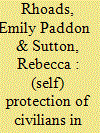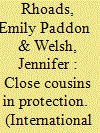|
|
|
Sort Order |
|
|
|
Items / Page
|
|
|
|
|
|
|
| Srl | Item |
| 1 |
ID:
174644


|
|
|
|
|
| Summary/Abstract |
Over the past decade, a body of scholarship on civilian self-protection (CSP) has emerged, advancing understandings of civilian agency in war. In this article, we argue that CSP has been conceptualized in a narrow manner, reflecting the nascent status of the field. Scholars have focused on responses to threats directly related to the dynamics of conflict, physical in nature, and caused by the presence of armed groups. Using the case study of the Protection of Civilians (PoC) sites in South Sudan and drawing on over 150 interviews, we identify one type of protective response neglected in the literature: community and popular justice. Although the PoC sites provide a measure of protection, residents face a range of daily threats that are indirectly related to the conflict, such as crime. In this context, community justice emerged as a natural response, an overlooked yet vital form of CSP that addresses immediate protection needs and fulfills a social ordering function. By conceiving of justice in this way, this article aims to deepen understanding of civilian agency and start a conversation with scholars and practitioners about the boundaries of (self) protection.
|
|
|
|
|
|
|
|
|
|
|
|
|
|
|
|
| 2 |
ID:
167112


|
|
|
|
|
| Summary/Abstract |
The Protection of Civilians (PoC) in peacekeeping and the Responsibility to Protect (R2P) populations from atrocity crimes are two norms that emerged at the turn of the new millennium with the aim of protecting vulnerable peoples from mass violence and/or systematic and widespread violations of human rights. To date, most scholars have analysed the discourses over the status, strength and robustness of both norms separately. And yet, the distinction between the two has at times been exceptionally fine. In this article, we analyse the constitutive relationship between PoC and R2P, and the impact of discursive and behavioural contestation on their joint evolution within the UN system and state practice over three phases (1999–2005; 2006–10; 2011–18). In so doing, we contribute to the International Relations literature on norms by illuminating ideational interplay in the dynamics of norm evolution and contestation. More specifically, we illustrate how actors may seek to strengthen support for one norm, or dimension of a norm, by contrasting it or linking it with another. Our analysis also reveals that while the two norms of R2P and PoC were initially debated and implemented through different institutional paths and policy frameworks, discursive and behavioural contestation has in more recent years brought them closer together in one important respect. The meaning ascribed to both norms—by representatives of states and institutions such as the United Nations—has become more state-centric, with an emphasis on building and strengthening the capacity of national authorities to protect populations. This meaning contrasts with the more cosmopolitan origins of R2P and PoC, and arguably limits possibilities for the external enforcement of both norms through any form of international authority that stands above or outside sovereign states. This article forms part of the special section of the May 2019 issue of International Affairs on ‘The dynamics of dissent’, guest-edited by Anette Stimmer and Lea Wisken.
|
|
|
|
|
|
|
|
|
|
|
|
|
|
|
|
|
|
|
|
|